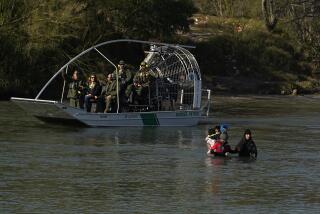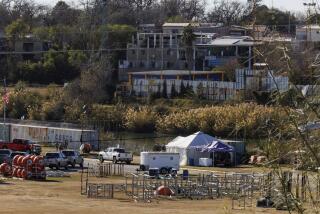Coast Guard Forcibly Halts Cuban Refugees
MIAMI — The U.S. Coast Guard on Tuesday tried to stop six Cuban refugees from reaching American soil by using a water cannon to sink their small wooden rowboat during a desperate drama that has outraged this community of immigrants and exiles.
After forcing the six men into the Atlantic Ocean a few dozen yards off Surfside beach, several Coast Guard vessels circled around them, blocking their efforts to swim ashore. At one point, a Coast Guardsman was seen dousing one tiring swimmer in the face with pepper spray.
Eventually, four of the migrants gave up the struggle to evade capture and were hauled aboard a Coast Guard cutter. But two others skirted the mini-blockade and, as some 50 onlookers cheered them on, made it to the beach.
There the pair, clad only in bathing suits or underwear, were quickly wrestled to the sand and handcuffed by police.
Normally, Cubans picked up at sea are repatriated to their Communist homeland, while those who reach shore are permitted to stay in the U.S. After a year, they can apply for permanent residency.
Televised live by news helicopters overhead and by cameras on the beach, the incident touched off an immediate and angry protest in Miami, home to tens of thousands of Cuban exiles.
“I just don’t understand this,” witness Enrique Pollack told WTVJ-TV. “I remember the images of people trying to cross the Berlin Wall and we’re acting like Gestapo or the Stasi, keeping them from coming to freedom.”
Within minutes of the late-afternoon incident, a group of about 25 people--many waving Cuban flags and yelling: “You almost killed them” and “Free them”--marched down the MacArthur Causeway to the Miami Beach Coast Guard station, blocking rush-hour traffic in both directions. Despite rain, the crowd grew to hundreds of people.
Other protests were staged outside the Coast Guard station in Marathon, in the Florida Keys, and in the heavily Cuban city of Hialeah, where hundreds of people blocked a main intersection well into the night.
“I saw 40 years of being proud of the Coast Guard going down the drain,” Miami-Dade Commissioner Tomas Regaldo said.
“Totally uncalled for,” Miami City Commissioner Joe Sanchez said. “They are human beings. That should never happen.”
Spanish-language talk radio was abuzz with outrage over the incident. “I really could not believe my eyes,” said Ninoska Perez, a talk-show host and official of the Cuban-American National Foundation. “I have always respected the Coast Guard, but to put a water cannon on that small boat . . . “
In a hastily called news conference, Coast Guard Lt. Ron LeBrec said that “the Coast Guard has a policy of using the minimum amount of force necessary to enforce U.S. laws and keep people safe” and added that the agency will investigate how it dealt with the Cuban refugees.
Other Coast Guard officers said that before the 14-foot boat sank, the Cubans had tried to fend off authorities with oars and with their bare hands.
Late Tuesday, the Coast Guard announced that the four men aboard the cutter would be brought to shore and turned over to immigration officials.
Coast Guard Capt. Greg Sutton also apologized for the use of pepper spray, saying, “this is not a common or accepted practice.”
Cuban-born Rep. Lincoln Diaz-Balart (R-Fla.) put a political spin on the incident, saying that the Coast Guard was “following orders not to offend [Cuban President Fidel] Castro” by returning Cubans attempting to flee the island.
Saying he was “outraged, appalled and aghast at the brutal treatment” of the migrants, Diaz-Balart called for an investigation into the Coast Guard’s actions and demanded that the refugees taken aboard the cutter be released.
Until the summer of 1994, almost all Cubans who reached U.S. shores were permitted to stay as refugees from a Communist dictatorship. But after more than 30,000 Cubans set sail that year--most on flimsy inner-tube rafts--the Clinton administration and the Castro government agreed on immigration accords designed to curb illegal entries from the island just 90 miles from Key West.
Along with providing visas for 20,000 immigrants a year, the U.S. agreed to repatriate any Cubans picked up at sea. Those who reach shore, however, are processed by the U.S. Immigration and Naturalization Service, and usually paroled into the community within days.
Since 1994, illegal immigration from Cuba has slowed from thousands a year to hundreds. Most now arrive in speedboats piloted by smugglers.
Although it is common knowledge that reaching shore is the key to a Cuban migrant’s gaining entrance to the U.S., there is widespread confusion over what constitutes reaching land. The U.S. territorial limit is 12 miles.
“These days, the INS seems to be saying: ‘If you’re in water ankle deep, you’re still at sea,’ ” Miami immigration attorney Cheryl Little said. “This is something I couldn’t have imagined seeing a couple of years ago.”
Damian Fernandez, a Florida International University professor of international relations, predicted that the incident Tuesday will force a clarification of U.S. immigration policy regarding Cuban migrants.
“Initially, the Coast Guard was to intercept boats at sea. Now they are becoming increasingly violent in stopping people,” Fernandez said. “They have been put in a awkward, untenable situation, and this was a dramatic, shameful example.”
Apart from those Cubans who have entered the U.S. illegally this year, the Coast Guard has intercepted 826 at sea. Most have been returned to Cuba. Last year 1,047 Cubans were interdicted, according to Coast Guard figures.
More to Read
Sign up for Essential California
The most important California stories and recommendations in your inbox every morning.
You may occasionally receive promotional content from the Los Angeles Times.










